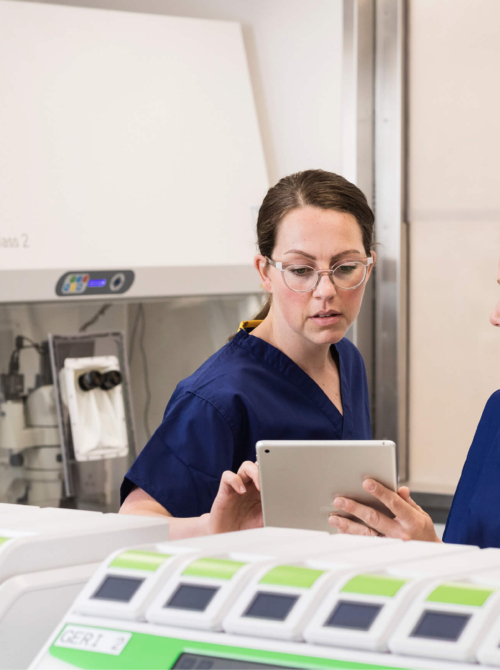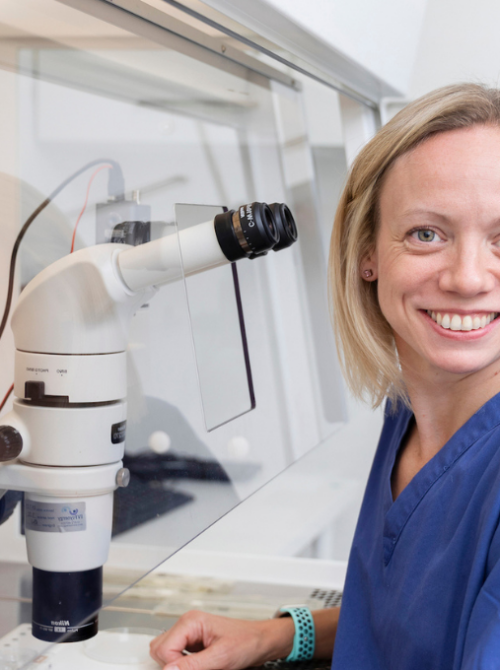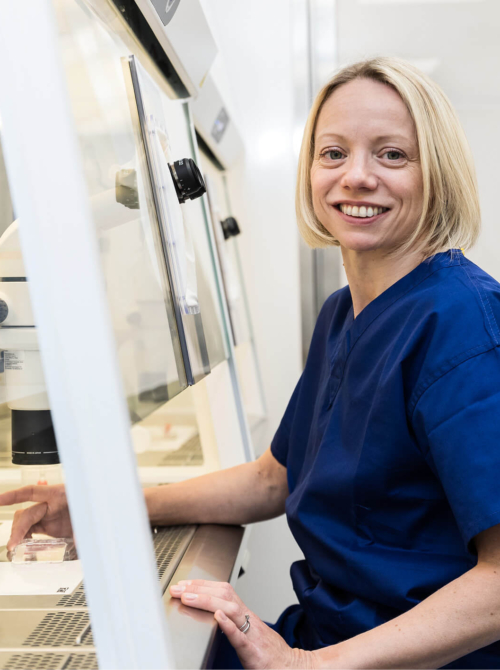Time-lapse incubators: transforming IVF for patients and embryologists
In recent years, few technologies have made as much impact in assisted reproduction as the time-lapse incubator. At The Evewell, I believe time-lapse embryo monitoring is possibly one of the most powerful innovations in IVF (in vitro fertilisation) in the last decade. It changes the way embryologists work and the way patients experience their fertility journey.
In the video below, Emma Whitney, Director of Embryology and Genetics at The Evewell, explains what timelapse incubators are and why they’re a vital part of modern IVF treatment.
What is a time-lapse incubator?
A time-lapse incubator is a specialised embryo incubator with built-in cameras that constantly monitor embryo development without needing to remove the embryos from their stable (body temperature) environment.
In contrast, traditional (or “closed”) incubator systems require that embryos be removed periodically, for example, once or twice daily, for visual microscopic assessment. Each removal introduces small fluctuations in temperature, humidity and gas concentration, which may stress the embryo and cool it to below body temperature.
With time-lapse incubator systems, embryos remain in a controlled environment that precisely mimics the body’s natural conditions, including body temperature (37°C), throughout their development. Every embryo has a camera placed above it, capturing images at defined intervals (often every 5–20 minutes). These sequential images are compiled into a video (time-lapse), showing the dynamic progress of cell divisions, morphological changes, and blastocyst formation.
This continuous, non-invasive observation, combined with a perfectly stable environment, is one of the reasons time-lapse technology has been such a breakthrough in IVF.
How does time-lapse help embryologists?
From my perspective in the lab, time-lapse incubators offer several concrete benefits:
- Continuous monitoring and undisturbed environment: Embryos stay in ideal conditions (temperature, gas, humidity) throughout their culture period. We avoid removing them for checks, so there is less disturbance.
- Better embryo selection: Not just how an embryo looks at a static moment, but when it divides, how symmetric the cell divisions are, the timing to reach 2-cell, 3-cell, 5-cell stages, etc. Being able to study these parameters (timing, division patterns) strongly correlates with implantation potential and pregnancy success.
- Reduced workload and improved workflow: Because images are captured automatically, embryologists can review embryo development remotely, compare growth curves, and make decisions with more data, often reducing the need for manual checks. This helps with lab staffing and can improve work-life balance.
- Greater transparency and record keeping: Time-lapse systems generate video records or image sequences that can be reviewed, shared, annotated, or used for consultation. This provides an audit trail and helps understand why some embryos perform poorly. If a cycle fails, we can often trace it back to abnormal division patterns to better counsel patients.
The patient benefits: what time-lapse means for you
For anyone going through IVF, time-lapse incubators offer multiple advantages:
- Increased chances of success: More precise embryo selection may increase implantation rates and reduce the risk of transferring embryos unlikely to succeed. While not every study shows large gains in live birth rates, many reports suggest better usable blastocyst rates and fewer failed cycles.
- Embryos stay at body temperature (37°C): Perhaps the most reassuring benefit for patients is that embryos never leave the carefully controlled environment of the incubator. In traditional systems, removing embryos for checks exposes them to changes in temperature and air. With time-lapse, embryos remain undisturbed in conditions that precisely mimic the body, including stable body temperature, throughout their development.
- Less risk, more comfort: Because embryos aren’t removed, there’s reduced risk of exposure to temperature fluctuations, air, light and other stressors. A more stable culture environment is generally better for embryo health.
- More information, more involvement: Patients often appreciate seeing more of the journey. Knowing how cell divisions have gone, seeing development videos, and understanding why some embryos are chosen or not gives a sense of ownership, clarity, and understanding.
- Potential to reduce multiple pregnancies: Improved embryo selection increases the possibility that clinics can confidently transfer a single embryo, reducing the risks associated with twin or multiple pregnancies.
Limitations and what the science says
It’s important to be realistic. Time-lapse incubators are not a guarantee of success. Some considerations include:
- Cost and accessibility: These incubators are more expensive to purchase, maintain, and run. Not all IVF clinics offer them as standard of care. Sometimes they are offered as an optional upgrade.
- Variable outcomes in studies: While many observational studies and smaller trials show benefits (better blastocyst rates, better embryo selection, reduced stress on embryos), large systematic reviews and randomised controlled trials sometimes show only modest improvements in live birth rates. Research is ongoing into which patient groups derive the most advantage.
- Data overload and interpretation: More information means more complexity. Embryologists need good software, algorithms, training, and “morphokinetic models” to interpret which time-lapse features matter most (timing of divisions, synchrony, etc.).
- Not replacing genetic tests: Time-lapse imaging provides dynamic morphological and division-timing data, but does not replace genetic screening (such as PGT) when that is indicated.
Time-lapse in practice: examples, systems and case use
- Geri incubator: Systems such as Geri allow continuous monitoring of embryos with high-resolution imaging. They capture images frequently (as often as every five minutes) and allow embryologists to observe multiple focal planes.
- EmbryoScope and other integrated systems: EmbryoScope is another time-lapse system used in many clinics, designed to support embryo culture, selection, and improve pregnancy success rates by continuous observation.
- AI and decision support tools: Some time-lapse systems integrate algorithms or scoring tools (morphokinetic prediction models) to help embryologists assess which embryos are most likely to implant. These tools may use timing of cell divisions, symmetry, or other dynamic metrics to assist with embryo ranking.
How The Evewell uses time-lapse incubators
Using time-lapse incubators, we constantly observe embryos with cameras, never remove them for visual checks outside the incubator, and track their journey from the very first cell division to blastocyst formation. This not only improves safety and environment for embryo culture but also gives us insight into which embryos are likely to lead to successful pregnancies.
For patients who do not achieve pregnancy, the time-lapse record gives us critical data to understand “why”, what happened during fertilisation? Was there delayed cell division? Abnormal cleavage? Even small irregularities can sometimes explain outcomes. This informs changes in lab parameters or in future stimulation protocols, giving patients greater clarity and potentially increasing chances of success in future cycles.
Why we use time-lapse incubators at The Evewell
Time-lapse incubators are not just a technical upgrade; they’re a paradigm shift in IVF. For embryologists, they offer better data, safer environments, and more precise embryo selection. For patients, they offer clearer explanations, improved chances of success, and deeper involvement in a journey that is intimate and often emotionally challenging.
Most importantly, embryos remain safely undisturbed in an environment that exactly mimics the body, including stable body temperature (37°C), giving them the best possible conditions to develop.
At The Evewell, our ethos is to help you build your family. If we can’t achieve a pregnancy, we strive to help you understand why, so together we can make each cycle more effective. Time-lapse incubators are one of the tools enabling that transparency and improvement.If you’re considering IVF or want to understand how time-lapse embryo monitoring can help your treatment, please get in touch. We’re here to help you with expert guidance, real data, and compassion every step of the way.





